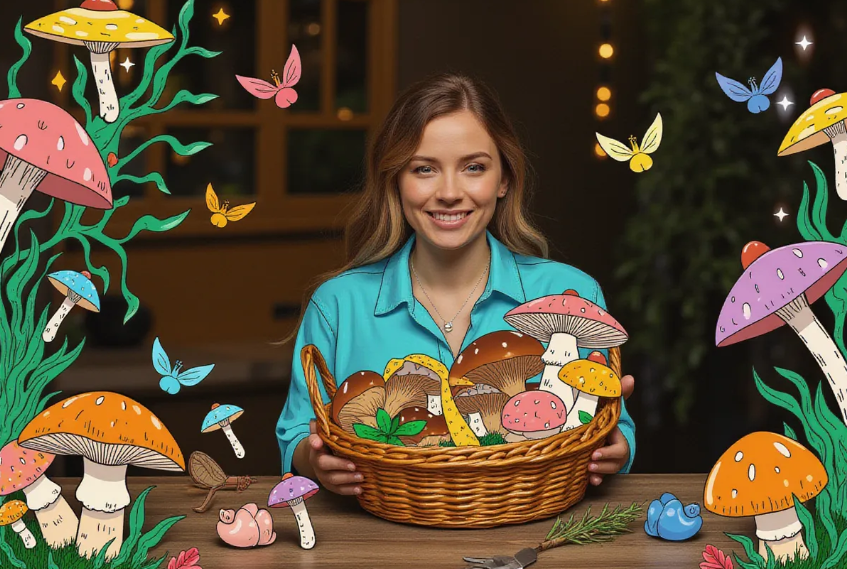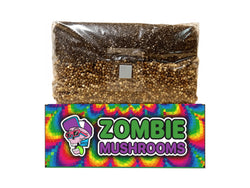⬇️ Prefer to listen instead? ⬇️
- Gourmet mushrooms taste better (more umami) and have more antioxidants than button mushrooms.
- Research suggests Lion’s Mane mushroom may help your brain and nerves work better.
- Growing mushrooms at home is easy, doesn't take up much room, and you don't need sunlight.
- Mushrooms can grow on farm waste and use much less water than regular crops.
- Some kinds, like Blue Oyster, grow really fast and can be ready to pick in just 10–14 days.
Mushrooms are becoming popular again in cooking and culture, but most people still use basic white button mushrooms. But good news! Gourmet mushrooms taste much better, are healthier, and are fun to grow at home. If you like to cook, care about health, or want to be more sustainable, looking past button mushrooms can show you a whole new world of flavors, textures, and health benefits.

Button Mushrooms: The Usual Mushrooms
Button mushrooms, called Agaricus bisporus by scientists, are the white or brown "regular mushrooms" you see in almost every grocery store. They have a mild taste and soft texture, so you can use them in lots of everyday dishes. They aren't the most nutritious, but they do have:
- B vitamins like riboflavin, niacin, and pantothenic acid
- Selenium, a mineral that's an antioxidant
- Fiber and a little potassium
Even though they are everywhere, button mushrooms are made for the mass market. They are grown to grow fast and last long on shelves, not to be as nutritious or flavorful as possible. Because they don't taste like much, they often just add bulk or texture to food, instead of being the main flavor.
Many people don’t know that white, brown (cremini), and portobello mushrooms are all the same type of mushroom, just picked at different ages. This shows that they are limited in taste and variety compared to real gourmet mushrooms.

More Than Buttons: Why Gourmet Mushrooms Are Worth Trying
Gourmet mushrooms are types other than Agaricus bisporus—and they are definitely not ordinary. These mushrooms give dishes strong character, and they often have compounds that are good for your health, much more so than white mushrooms.
So, what makes gourmet mushrooms special?
- Many Flavors: From nutty and earthy to tasting like seafood and savory.
- Great Textures: Meaty, silky, or crunchy textures make any dish better.
- Healthy Food: Many gourmet mushrooms have good things in them, like beta-glucans and ergothioneine, which may help your immune system and brain.
- Easy to Grow: Some kinds grow well inside and are easy to take care of.
Gourmet mushrooms aren't just fancier—they are healthier and tastier, and some might even be medicinal. This makes them a great choice instead of button mushrooms, especially if you cook at home or want to grow mushrooms yourself.

Popular Gourmet Mushroom Types You Can Grow at Home
Let’s look closer at some gourmet mushrooms that taste great and are easy to grow in small spaces or indoors:
Shiitake (Lentinula edodes)
- Flavor: Rich umami taste with a hint of smoke
- Uses: Good in stir-fries, soups, and stews
- Health Benefit: Has lentinan, a beta-glucan studied for helping the immune system and fighting tumors
- Growing Tips: You can grow them on hardwood logs or bags of sawdust that have been sterilized
Blue Oyster (Pleurotus ostreatus)
- Flavor: Slightly sweet and smooth
- Uses: Great in creamy sauces, pasta, and when sautéed
- Health Benefit: Lots of ergothioneine, a strong antioxidant inside cells
- Growing Tips: Best for beginners—grows fast and is easy to grow on straw or sawdust
Lion’s Mane (Hericium erinaceus)
- Flavor: Delicate and like seafood, like crab or lobster
- Uses: Good pan-fried, shredded to make "crab cakes," or in soups
- Health Benefit: Studied for helping nerves grow (NGF)—may help thinking (Pham et al., 2021)
- Growing Tips: Likes humidity and does well in indoor growing boxes
Chestnut (Pholiota adiposa)
- Flavor: Nutty, a little spicy, and earthy
- Uses: Great roasted or in grain bowls
- Health Benefit: Full of antioxidants and fiber
- Growing Tips: Likes it cooler and not too much direct light
Pioppino (Agrocybe aegerita)
- Flavor: Strong and spicy; good for rich sauces
- Uses: Good in pilafs, pastas, and risottos
- Health Benefit: Has good polysaccharides that are antioxidants
- Growing Tips: Grows well on hardwood sawdust with added nutrients
Golden Oyster (Pleurotus citrinopileatus)
- Flavor: Delicate, a little fruity and buttery
- Uses: Stir-fry or cook quickly to keep their delicate shape
- Health Benefit: High in beta-glucans and can fight germs
- Growing Tips: Bright yellow mushrooms that look cool and grow fast, great if you want quick results
These mushrooms not only make meals better—you can easily grow them inside using kits, logs, or special containers, making them good choices instead of button mushrooms for home growers.

Nutrition & Health Benefits of Gourmet Mushrooms
Gourmet mushrooms are full of good nutrients. Recent studies show they are often better than white button mushrooms because they have more:
- Beta-glucans: Complex sugars that make your immune system stronger
- Ergothioneine: A special antioxidant mostly found in mushrooms
- Polyphenols and flavonoids: Things that reduce swelling and are good for your heart
- B vitamins: Help you have energy and your brain work
- Copper, potassium, and selenium: Important minerals for healthy nerves and protection against damage
Lion’s Mane, especially, has become known for things like hericenones and erinacines. These seem to help make nerve growth factor (NGF). A study in the Journal of Medicinal Food said that older people with early memory problems who took Lion’s Mane got better at thinking (Pham et al., 2021).
Research in Food Chemistry says that wild and special mushrooms have more of these good chemicals than common mushrooms like white buttons (Kalac, 2013; Carrasco-González et al., 2017).
Basically, gourmet mushrooms are more than just tasty—they are good for you and may help your immune system, brain, and health over time.

Making Everyday Cooking Taste Better
You don't have to be a professional chef to cook with gourmet mushrooms—just let them taste good naturally:
- Blue Oyster: Cook with butter and garlic; their smooth texture is great in creamy risottos or savory crepes.
- Shiitake: Slice and cook with tamari and sesame oil for a rich, savory side dish.
- Lion's Mane: Shred, pan-fry, then add lemon zest for a dish like crab.
- Chestnut: Put in winter stews—they stay firm and soak up flavors well.
- Pioppino: Cook with shallots and wine; their spicy, earthy taste adds something special to pasta dishes.
- Golden Oyster: Best cooked quickly with olive oil and herbs to keep their delicate flavor.
These kinds of mushrooms make simple weeknight meals feel special and let you try new tastes without needing hard recipes.

Gourmet Mushrooms That Are Easy to Grow for Beginners
You don’t need a fancy setup to start growing mushrooms at home. Think about starting with kinds that are:
- Fast-growing
- Can handle changes in conditions
- Grow well indoors
Best Choices for Beginners:
- Blue Oyster: Grows very fast; ready to pick in only 10–14 days.
- Lion’s Mane: Looks cool and is easy as long as you mist it to keep it humid.
- Shiitake (on blocks): Slower to start, but strong and worth it.
Small grow kits can sit on a counter or shelf, turning your kitchen into a small mushroom farm.

How to Start Growing Mushrooms
Growing mushrooms at home is easier than you might think. Here’s what you need:
- Grow kits or spawn: Kits come with mushroom material already started. Spawn lets you start your own.
- Substrate: Food for the mushrooms like sawdust, straw, or logs.
- Clean space: Keep things clean using alcohol wipes or gloves.
- Humidity and air: Use special containers, humidity tents, or spray bottles to keep moisture in.
- Light: Not too much light is good—no direct sun needed.
Getting supplies from good places like Zombie Mushrooms makes it simpler. Their kits often have everything you need, from mushroom food to spray bottles, so even beginners can grow mushrooms at home.

Why It's Not As Hard As You Think
Most people think gardening takes a lot of time. But growing mushrooms is different:
- Small: Can fit on a bookshelf or counter
- Little sun needed: Doesn't need sunlight
- Few pests: Indoor setups don’t get many pests
- Fast harvests: Some mushrooms like oysters are ready in less than two weeks
- Grow all year: Grow gourmet mushrooms inside no matter the season
Growing mushrooms doesn’t replace gardening—it adds to it by giving you a different way to grow food that doesn't need soil or sun.

Good for the Earth
Mushrooms are one of the most earth-friendly foods you can grow:
- Recycled food: Grows on waste like straw, coffee grounds, and sawdust
- Uses little water: Less than meat or many vegetables
- Smaller footprint: Especially when grown at home, less packaging and travel needed
- Quick to grow: Can pick often without plowing or hurting soil
As people want to live more sustainably, growing mushrooms at home helps reuse waste and be more earth-friendly with food.

How Mushroom Suppliers Like Zombie Mushrooms Help You
If you are new to mushroom growing, brands like Zombie Mushrooms sell good supplies that make it easier to grow fungi:
- Beginner kits: Mushroom blocks that are already started with easy directions
- Good spawn: Liquid and grain spawn for growing different kinds of mushrooms
- Clean tools: Gloves, filters, and containers to keep things from getting contaminated
- Helpful info: Blogs and guides to help you learn about growing fungi
Using good mushroom gear helps you succeed at first—and encourages you to try growing more kinds over time.

Tips for Growing Gourmet Mushrooms Well
Want to grow lots of good mushrooms at home? Here are some tips:
- Start easy: Use beginner kits with Blue Oyster or Lion’s Mane
- Keep it humid: Spray water daily or use a humidity tent to keep moisture in
- Let air in: Some air flow helps prevent mold and contamination
- No direct sun: Use bright, but not direct sunlight
- Pick before caps flatten: This is when they taste best and are freshest
Keep mushrooms fresh longer by storing them in paper (not plastic) in the fridge and eat them within a few days.
A Way to Better Food and Health
Gourmet mushrooms open the door to tastier meals, healthier living, and sustainable ways to grow food. Growing mushrooms at home is easy, doesn't need much space or sun—making it very doable. With the right things and a little interest, you can grow your own fresh, tasty, and healthy mushrooms right in your kitchen.
These mushrooms are not just tasty—they show you a way to better food, less harm to the earth, and a closer connection to what you eat.
From Kitchen Counter to Great Meal
If you've only used button mushrooms, try gourmet mushrooms. They have bolder flavors and textures, health benefits, and are easy to grow at home. Gourmet mushrooms are more than just good to eat. Take your first step into growing mushrooms with a beginner kit from Zombie Mushrooms and start growing flavor, health, and sustainability right on your counter.
Citations
- Carrasco-González, J. A., Serna-Saldívar, S. O., & Gutiérrez-Uribe, J. A. (2017). Nutritional composition and bioactive compounds of edible mushrooms. Food Reviews International, 33(4), 416–435.
- Kalac, P. (2013). A review of chemical composition and nutritional value of wild-growing mushrooms. Food Chemistry, 113(1), 9–16.
- Pham, H. T., Nagai, K., & Ito, H. (2021). Improvement of cognitive function in adults with mild cognitive impairment with Lion’s Mane mushroom supplementation. Journal of Medicinal Food, 24(3), 234-245.
- Royse, D. J., Baars, J., & Tan, Q. (2017). Current overview of mushroom production in the world. Edible and Medicinal Mushrooms: Technology and Applications, 5–13.




